While soap making may not initially seem like a lucrative endeavor, it presents a unique opportunity to blend creativity with practicality.
Plus, you can produce a product that’s always in demand. Whether you’re looking to satisfy your creativity or keen on tapping into a thriving market, soap making is an excellent choice.
Sold on the idea? Here, we’ll cover everything from the basics of crafting your first bar to strategies for transforming your newfound skill into a profitable home business.
What is soap making?
Soap making combines natural oils or fats with an alkali, typically lye, in a process called saponification. This reaction forms soap, which you can then customize with additives like fragrances and colors.
Key soap making steps include:
- Mixing: Oils are mixed with a lye solution, starting the saponification process.
- Molding: Pour the mixture into molds and leave it to set.
- Curing: The soap cures for several weeks to harden and complete the chemical process.
The benefits of starting a homemade soap business
A soap business combines art, science, and your personal flair, making it a fulfilling and potentially profitable business venture. Plus, it’s a business that can grow and evolve with your passion and creativity.
Thinking about diving into the soap-making business? Here’s why it’s a smart move:
- High demand: Soap is a daily necessity for everyone, ensuring a steady market demand. Plus, the growing interest in artisanal, handcrafted products makes it a timely choice.
- Creativity and branding: Soap making allows for creativity––from scents and colors to shapes and packaging. You can create a unique brand identity that stands out in the market.
- Eco-friendly and health conscious: Consumers look for natural, eco-friendly products. Handmade soaps with natural ingredients cater to this need, appealing to conscious customers.
- Profitability: The cost of materials is relatively low compared to the premium price consumers are willing to pay for handcrafted soaps. With the ability to start small and scale up, soap making can be profitable.
- Flexibility: This business can start as a home-based operation, allowing for a flexible schedule and lower overhead costs. It’s perfect for entrepreneurs who want to balance work and personal life.
- Educational opportunities: As a soap maker, you can offer workshops and DIY kits, adding an educational aspect to your business that engages customers.
- Community connection: Handmade soaps can be a hit at local markets and events, helping you build a strong community presence and brand loyalty.
- Online sales potential: Soap is easy to package and ship, making it an excellent product for online sales and expanding your reach beyond local customers.
How to make soap to sell online
- Gather your soap ingredients
- Prepare your workspace
- Get your soap base ready
- Stir and combine
- Pour your soap and let it set
- Cure the homemade soap
- Unmold and cut
- Package and label your soap
1. Gather your soap ingredients
Begin by assembling all your ingredients. This includes your fats or oils, lye, water, fragrances, colorants, and any additional additives you plan to use.
Combining different oils will lend your final product different characteristics. Some oils will help make your bars harder or provide a better lather. On the other hand, oils like olive and coconut will create a chemical reaction that actually turns all these liquids into soap. Other materials like shea butter will offer moisturizing qualities.
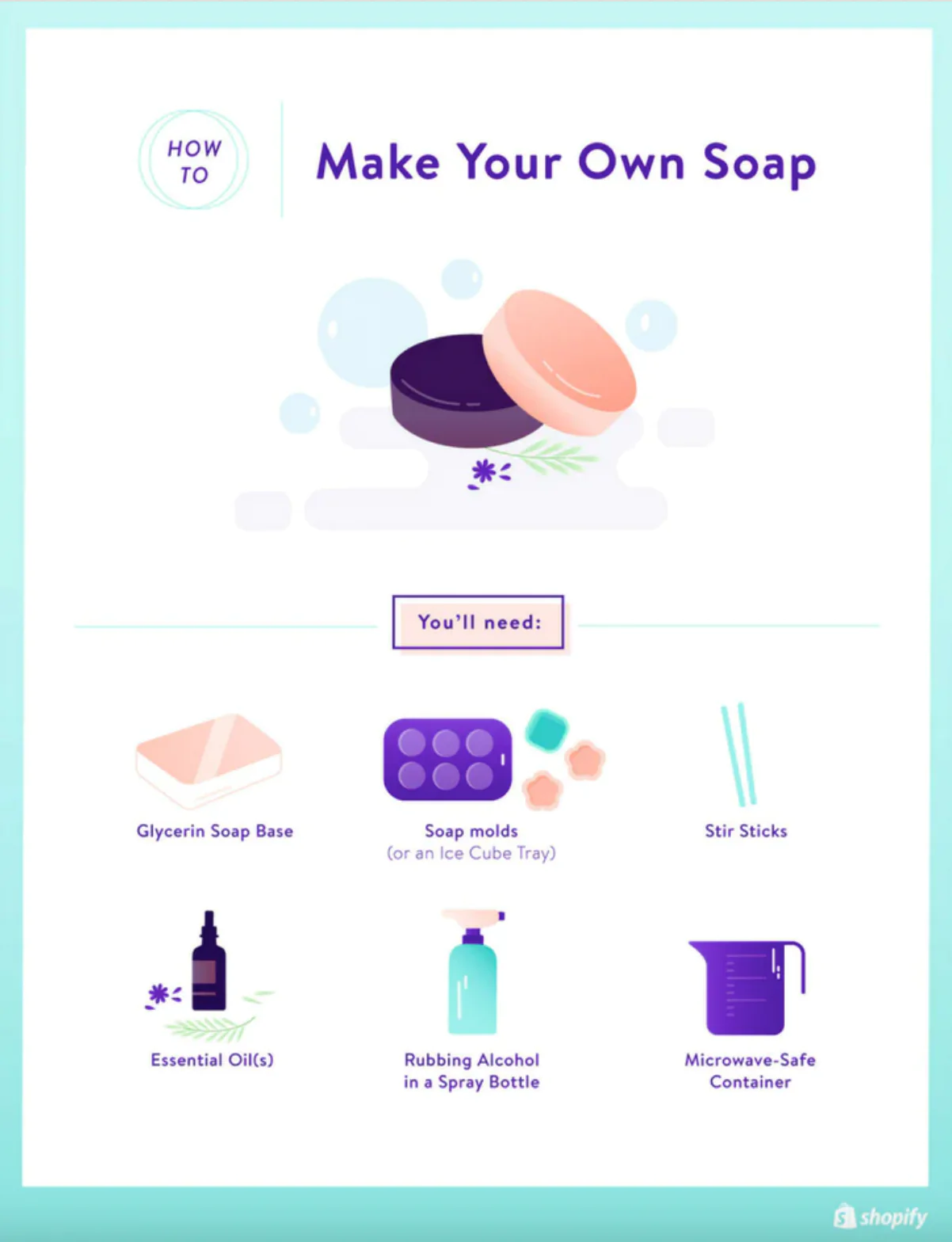
Whether you’re aiming to create a luxurious product or something simple and natural, these key ingredients are essential for crafting high-quality soap:
- Fats and oils: The base of every soap recipe. Common choices include coconut oil for lather, olive oil for smoothness, and palm oil for hardness. Each oil brings something special to the table, so mix and match to suit your brand.
- Lye (sodium hydroxide): The essential ingredient that turns oils into soap. Safety is crucial when handling lye, so always follow proper guidelines.
- Water: It’s mixed with lye to create the saponification process. Distilled water is best for preventing impurities.
- Glycerin base: Grab a bulk amount from a site like Soap Artisan, Naturally Balmy, Craftiviti, or even Etsy.
- Stir sticks: You can acquire these from almost any grocery store or your local craft store.
- Rubbing alcohol: Pharmacies, dollar stores, and bulk retailers will have bottles of this readily available.
- Microwave-safe containers: Kitchen suppliers or craft stores carry these.
- Fragrances and essential oils: These give your soap its signature scent. From calming lavender to refreshing citrus, pick fragrances that align with your brand’s image.
- Colorants: Whether natural or synthetic, colorants add visual appeal to your soap. Natural options include clays and plant extracts.
- Additives: Ingredients like aloe vera, oatmeal, or honey can add special properties, like moisturizing or exfoliating.
- Preservatives: If you’re adding ingredients like milk or fruit purees, you might need a preservative to extend the shelf life of your soap.
Choosing the right ingredients defines the quality of your soap and your brand. Think about what each ingredient means for your customers and how they align with your store’s values, like sustainability, luxury, or health consciousness.
2. Prepare your workspace
Ensure your workspace is clean, organized, and well-ventilated. Lay out all your tools and ingredients for easy access. Safety is paramount, so use gloves and goggles.
Having the right tools also makes the process smoother and ensures the safety and quality of your soap products. Here’s what you’ll need in your workspace:
- Safety gear: Always wear gloves and goggles to protect your skin and eyes from lye.
- Digital scale: Precision is key in soap making. A digital scale ensures accurate measurements of ingredients.
- Stainless steel pot: This is used to melt your oils and mix them with lye. Avoid aluminum, as it reacts with lye.
- Thermometer: Temperature control is crucial. A thermometer helps you check the temperature of your lye and oils.
- Immersion blender: This speeds up the saponification process and helps achieve “trace” faster.
- Silicone spatulas: Great for stirring and scraping out every bit of soap mixture.
- Soap molds: These come in various shapes and sizes. Silicone molds are popular for easy removal of the soap.
- Measuring cups and spoons: These are used to measure smaller amounts of additives like fragrances or colors.
- pH test strips: To check the pH level of your soap to ensure it’s skin-friendly.
- Cooling rack: For air circulation around your soap as it cures.
Investing in these tools is the first step toward crafting unique, high-quality soaps that can set your store apart. The quality of your tools can directly affect the quality of your soaps, so choose wisely!
3. Get your soap base ready
If you’re using a melt-and-pour base, simply melt it in a microwave-safe container or use a double boiler.
If you’re using a glycerin base, cut small chunks of glycerin, place them in your microwave-safe container, and microwave for 30 seconds.
For cold-process soap making, you’ll need to carefully mix your lye with water and then combine it with your oils.
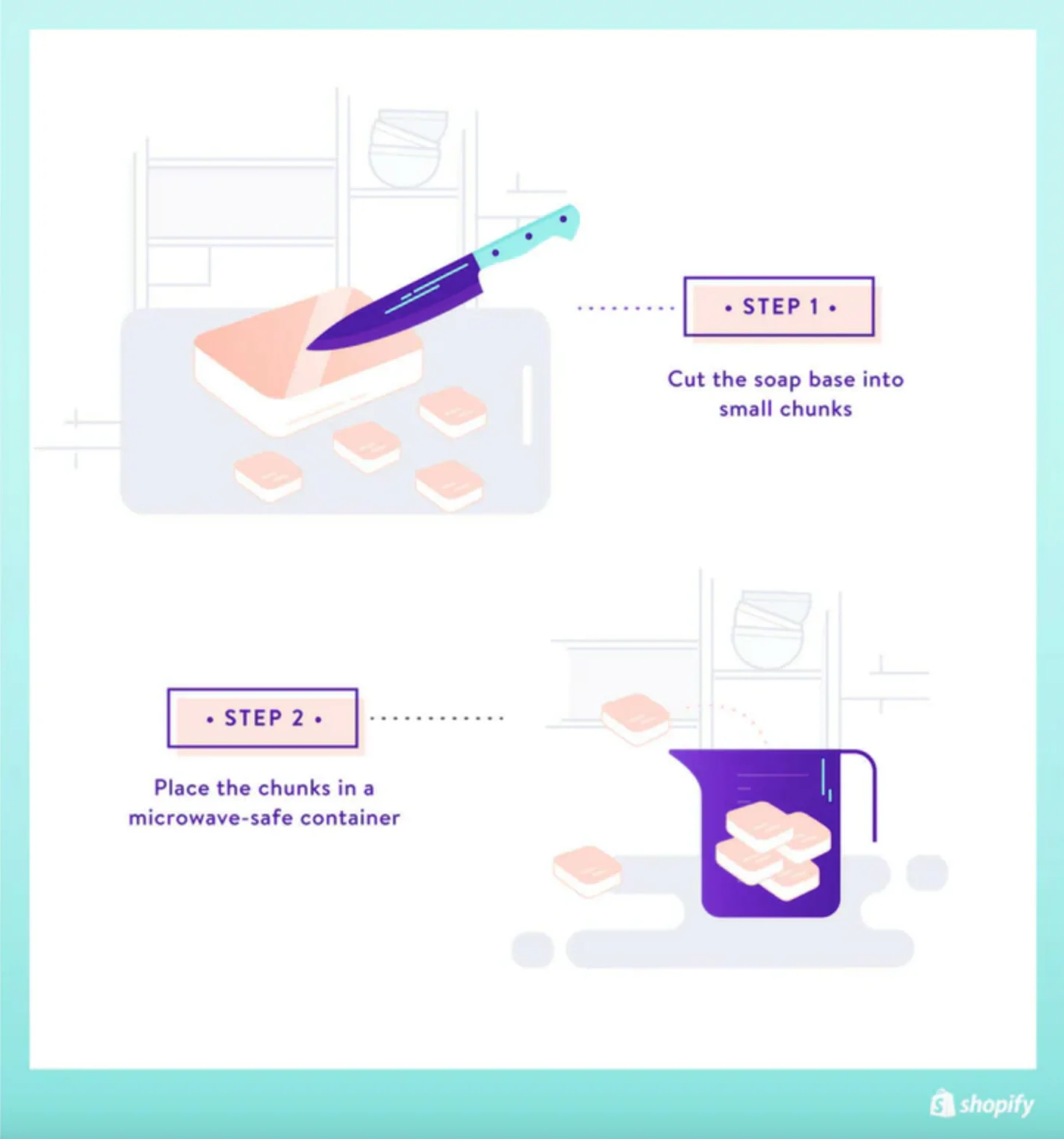
4. Stir and combine
Once your base is ready, it’s time to add in your fragrances, colorants, and any other additives. Stir the mixture thoroughly to ensure an even distribution of all ingredients.
While those ingredients are combining, use a spray bottle to spritz rubbing alcohol on your molds to prevent any bubbles from forming in your bars of soap.
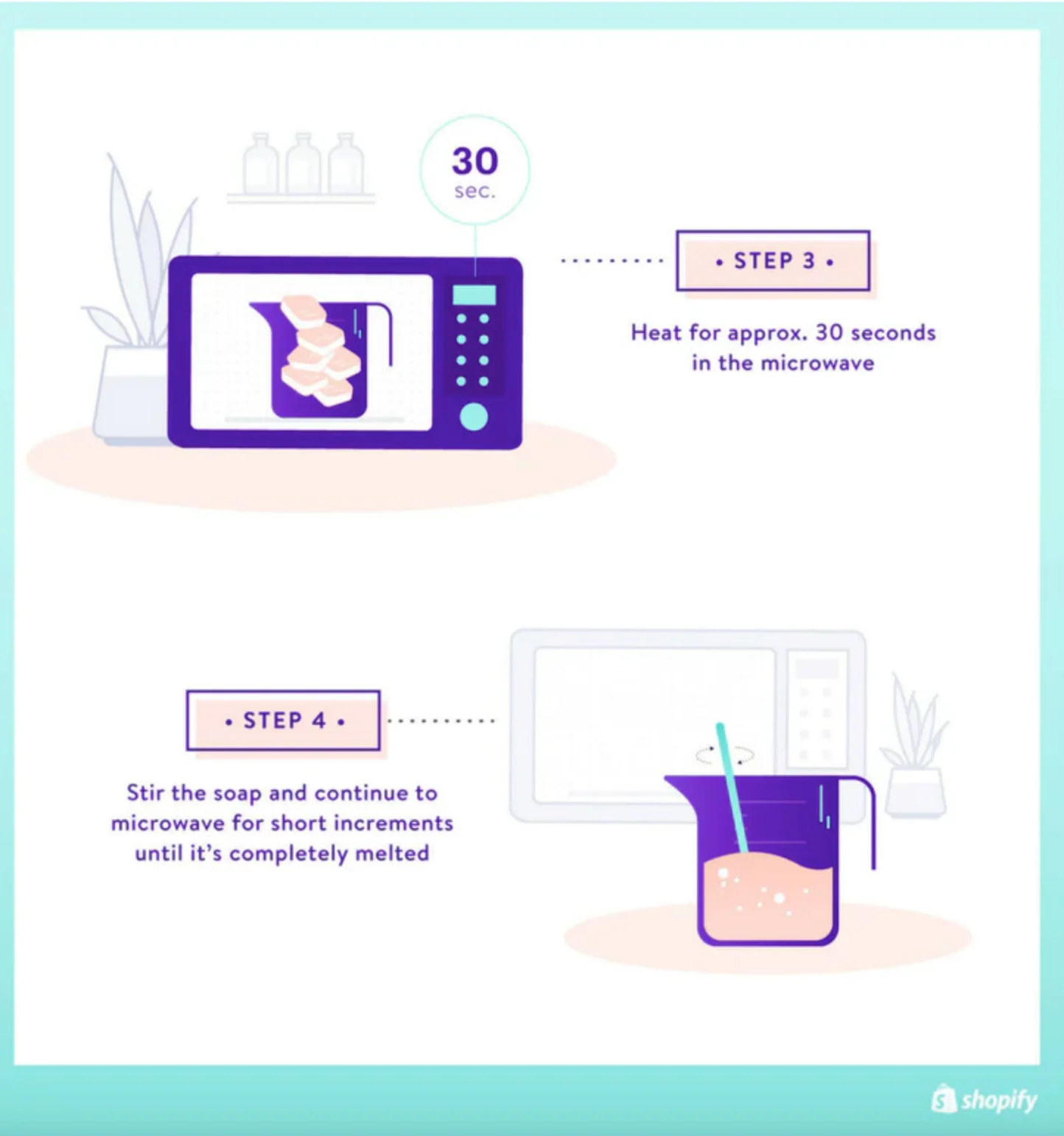
5. Pour your soap and let it set

Carefully pour the soap mixture into molds. Tap the molds gently to remove any air bubbles. When the bars have hardened, pop them out of the molds and your bars are complete. From here, simply lather, rinse, and repeat.
6. Cure the homemade soap
For cold-process soap, you need to cure it, which means allowing it to rest in a dry, ventilated area for about four to six weeks. This process allows the soap to fully saponify and harden.
7. Unmold and cut
Once the soap has set or cured, gently remove it from the molds. If you have larger blocks, use a soap cutter or a knife to cut them into bars.
8. Package and label your soap
Wrap your soap bars to protect them from moisture and dust. Don’t forget to label them with your brand and any relevant information, like ingredients or usage instructions.
How to sell soap online
Successfully starting a business selling your handmade soap involves more than just creating a great product. You need to connect with your audience, set the right prices, and leverage various platforms to showcase your soaps.
Here are some effective strategies:
Find your unique selling point
Crafting soaps that stand out in a crowded market requires creativity, experimentation, and an understanding of what appeals to your target audience. Here are some key strategies to make your soap products irresistible to customers.
Experimenting with different scents and colors
The aroma and visual appeal of your soap are its first points of contact with customers. Experimenting with a variety of scents and colors can help you find combinations that resonate with your audience. Consider the following:
- Seasonal themes: For instance, warm cinnamon scents in autumn or floral tones in spring.
- Color psychology: Use colors to evoke emotions or themes, like calming blues or energizing oranges.
- Essential oil blends: Mix essential oils to create signature scents.
Adding unique ingredients for special soap varieties
Incorporating special ingredients not only adds a unique selling point but also caters to specific customer needs. Think about:
- Natural exfoliants: Ingredients like oatmeal, poppy seeds, or coffee grounds.
- Skin benefits: Additives like aloe vera or goat’s milk for their nourishing properties.
- Specialty oils: Argan, jojoba, or almond oil for luxury soap lines.
Designing attractive soap packaging
Your packaging is a powerful tool for branding and can significantly influence purchasing decisions. Focus on:
- Eco-friendly materials: Sustainability is a growing concern among consumers.
- Branding consistency: Ensure your packaging reflects your brand’s ethos and aesthetic.
- Practicality and protection: While aesthetics are important, the packaging should also protect the soap and maintain its quality.
The key to creating marketable soap products lies in understanding your market and continually innovating to meet and exceed customer expectations. Your soap isn’t just a cleansing product—it’s an experience, a lifestyle choice, and a reflection of your brand’s values.
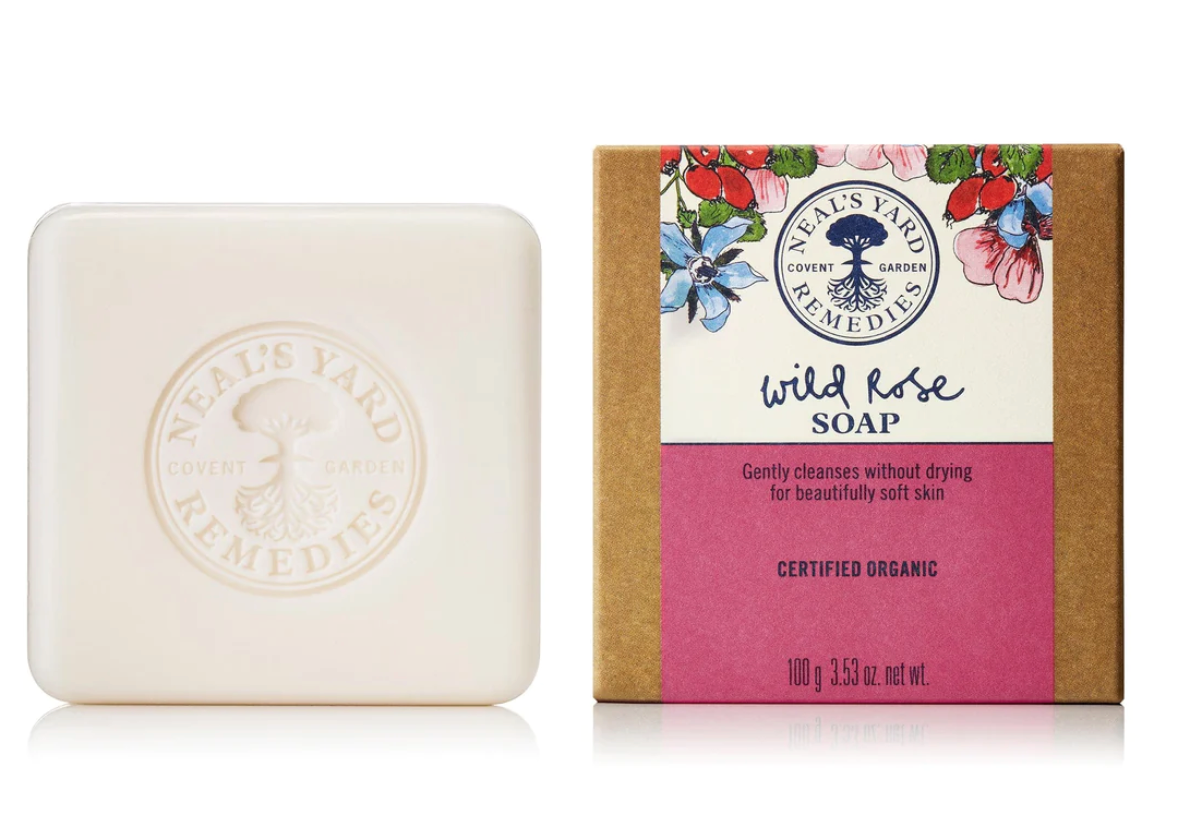
Check soap licensing laws
In the US, there are specific licensing requirements around selling soap. However, there are some guidelines you’ll need to follow:
- Disclose all ingredients: The Modernization of Cosmetics Regulation Act of 2022 requires a full ingredient list for all “cosmetic products.” Not all soaps fall under this category, but you should check to make sure.
- Include cautionary labels: The FHSA states that any product including a “hazardous substance” must include a cautionary label about the potential hazards, such as “keep out of reach of children.” Check to make sure your soaps don’t include these types of ingredients.
- “True soaps”: The CPSC regulates true soaps deemed by the FDA, checking for “nonvolatile matter” in the ingredients, which ingredients cause the cleaning action, and how it’s intended to be used—for example, it should only be labeled, sold, and represented as soap, sans any promises about moisturizing, smell, deodorizing the body, treating skin conditions (like acne or eczema), or killing germs.
If you’re selling a non-cosmetic, non-“true soap” then you generally won’t need to worry about much, though it’s always best to check in your local jurisdiction. There’s also no legal testing requirement before you go to market.
It’s always a good idea to include ingredients, quantity of contents, and your business information on soap labels or packaging.
Create an online store
To get in front of a larger target audience, an online store is essential. Here’s how to set yours up for success:
- User-friendly design: Create a clean, navigable, and visually appealing website.
- High-quality product images: Showcase your soaps with professional-grade product photos.
- SEO: Use relevant keywords and descriptions to improve your site’s visibility.
- Customer engagement: Include features like product reviews, blogs, or newsletters.
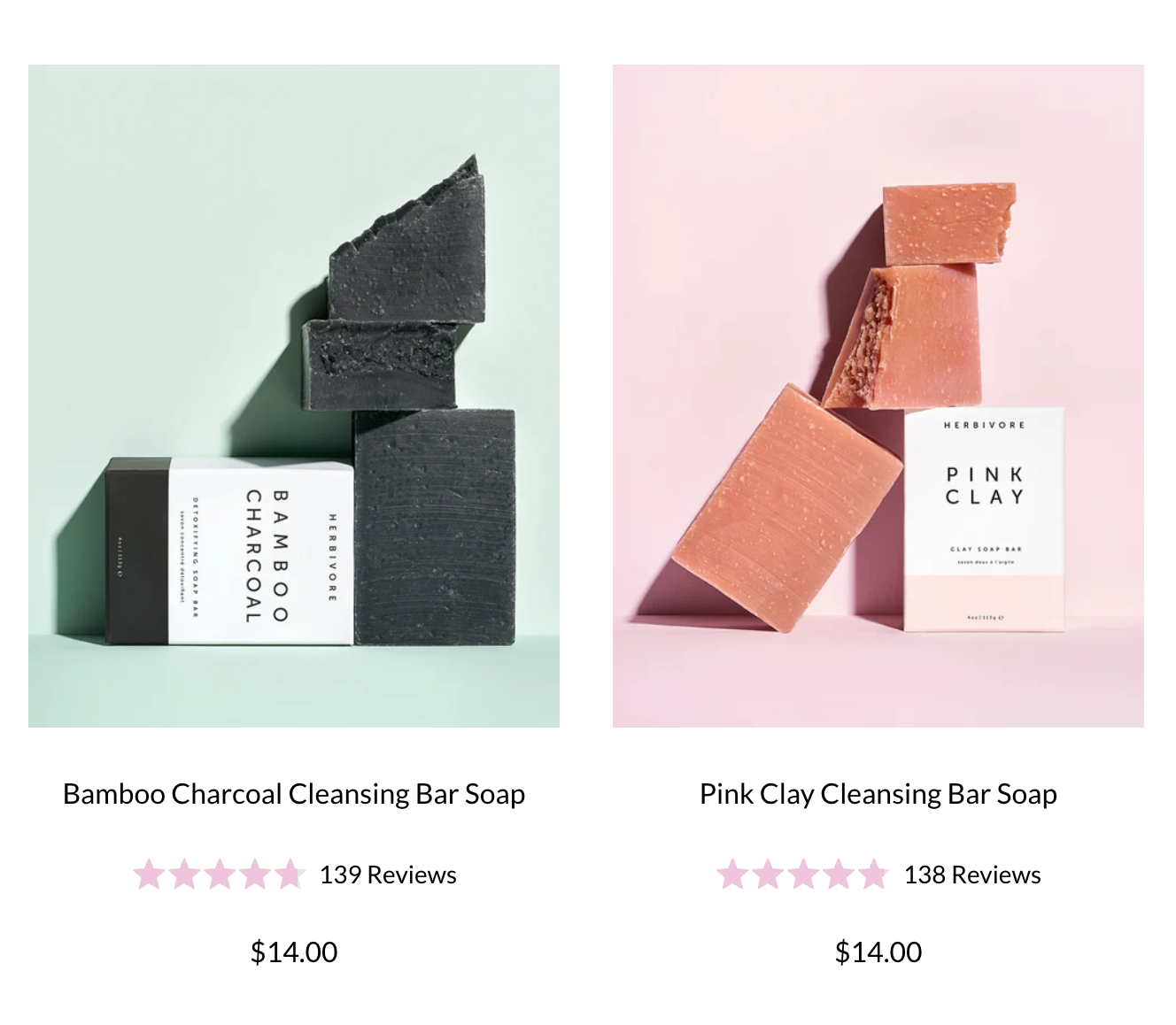
Price your homemade soap
Pricing is key to your business’s viability and growth. Consider these points:
- Cost-plus pricing: Calculate your costs and add a markup for profit.
- Competitive analysis: Research prices of similar products in the market.
- Perceived value: Price can reflect the quality and exclusivity of your soap.
- Flexibility: Be open to adjusting prices based on feedback and sales trends.
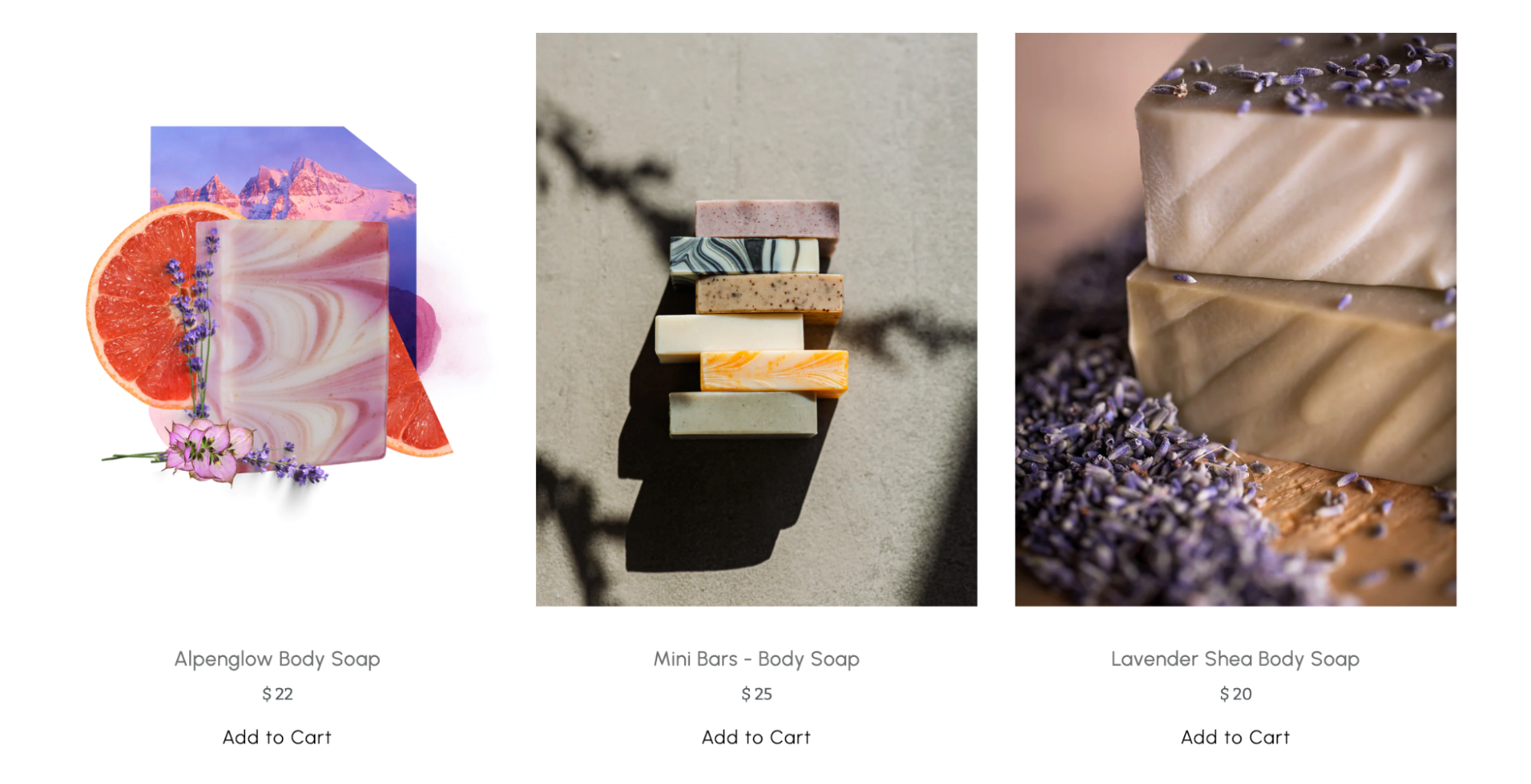 Boutique brand Osmia Organics clearly displays soap pricing next to listings and photos.
Boutique brand Osmia Organics clearly displays soap pricing next to listings and photos.
Promote your soap on social media
Social media is a powerful tool to reach and engage with your audience. Here’s how to use it effectively:
- Consistent branding: Maintain a consistent style and tone across all platforms.
- Engaging content: Share behind-the-scenes looks, customer testimonials, and soap-making processes.
- Regular posting: Keep your brand top of mind with frequent updates.
- Cross-promotion: Use various platforms like Instagram, Facebook, Pinterest, and even TikTok to reach different audiences.
In addition to social media, consider other platforms like local markets, pop-up shops, and collaborations with other local businesses to expand your reach.
Effective marketing involves storytelling. Your brand’s story, values, and the uniqueness of your product should be at the heart of all your marketing efforts.
Sell soap at local craft fairs
In addition to selling your soap at retail stores and in your own online shop, you can take it on the road to fairs, markets, and festivals. Soap is easy to transport and display, so it’s great for event selling and temporary retail.
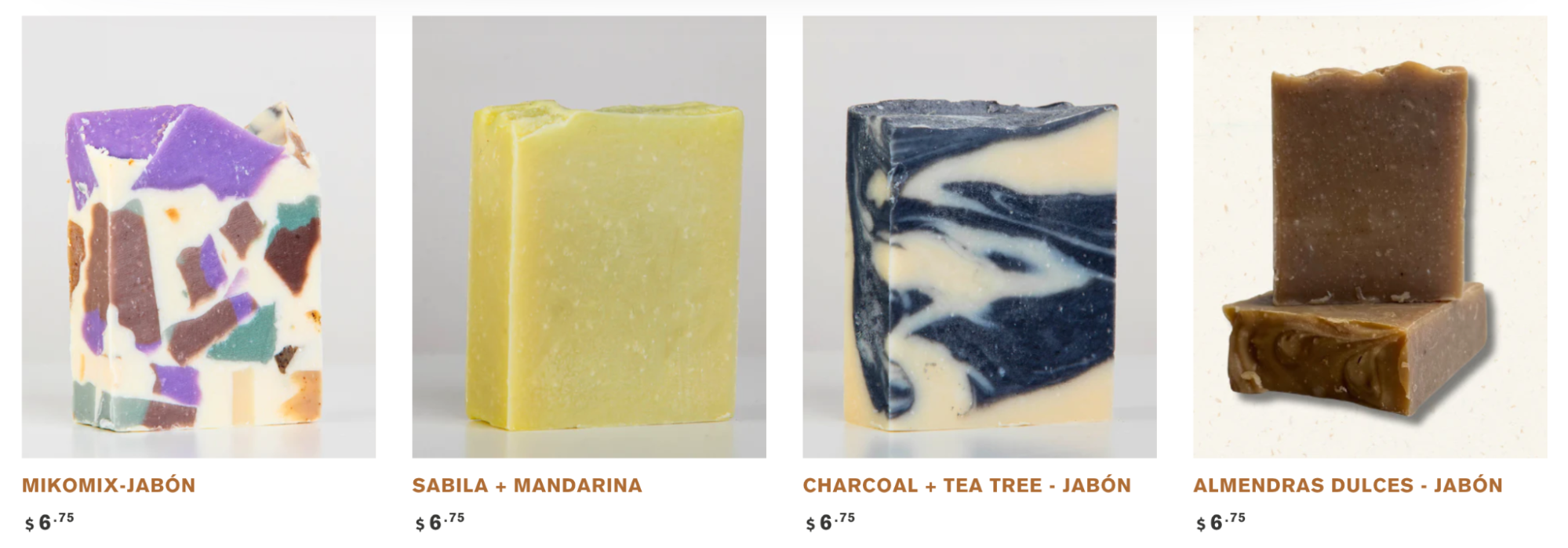
Shopify POS can hit the road with you, syncing data from your online and retail sales channels so you have it all in one place. Plus, you can take payments and collect customer data.
Start a profitable soap making business
By following this guide, you can start turning your soap making hobby into a lucrative business. Start by mastering soap making basics and gathering quality supplies. Develop unique products with appealing scents, colors, and ingredients, and ensure your packaging reflects your brand.
Next, create an online presence, adopt smart pricing strategies, and actively promote your products on social media. Then always stay adaptable to market trends and customer feedback.
Read more
- How To Work With a Developer to Build Your Retail Website
- 5+ Ways to Build Your Side Business Without Quitting Your Day Job
- Everything You Need to Know About Opening a Second Location for Your Business
- How to Open a Retail Store in Your Starter Guide
- How This Gemstone Retailer Is Making Sales Magic With Healing Crystals
- Find a Retail Location: 6 Options to Consider When Setting Up Shop in a New Area
- Shop-in-Shop: How to Capture Existing Foot Traffic with a Pop-In Shop
- POS Systems for Small Businesses: Best Features, Systems, and How to Choose
- 5 Successful Retail Businesses That Started Off as Side Hustles
- Retail Franchising 101: How to Take Advantage of Franchise Opportunities
How to make soap to sell FAQs
How do you make soap at home?
- Mix lye with water (always add lye to water, not the other way around).
- Melt and combine your chosen oils.
- Slowly mix the lye solution with the oils.
- Add fragrances or additives if desired.
- Pour the mixture into molds and let it set.
- Once solidified, unmold and allow the soap to cure, typically for four to six weeks.
Can I make soap and sell it online?
- Gather your soap ingredients
- Prepare your workspace
- Get your soap base ready
- Stir and combine
- Pour your soap and let it set
- Cure the homemade soap
- Unmold and cut
- Package and label your soap





